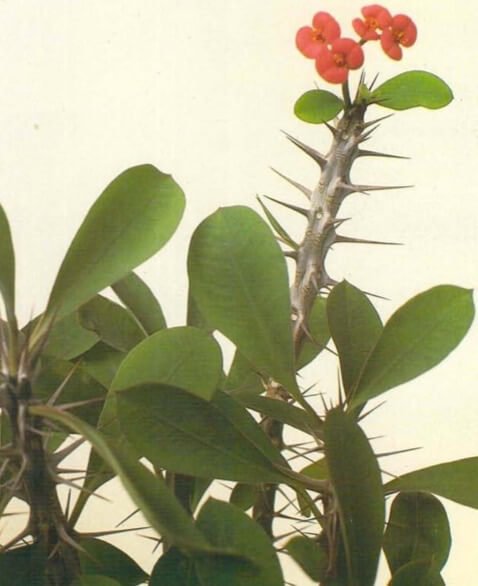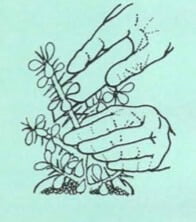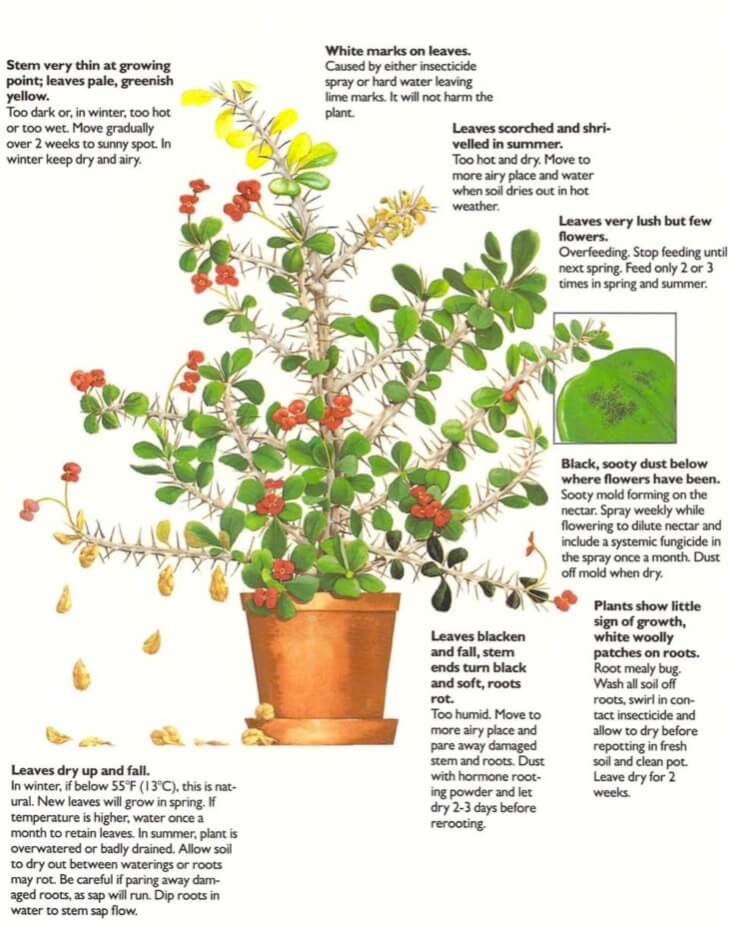[Ebook Việt Hoá] The Instant Guide to Healthy Houseplants (Hướng dẫn tức thời để chăm cây trong nhà khoẻ mạnh), Chi Euphorbia (Pedilanthus) - Chi Đại Kích
[Ebook Việt Hoá] The Instant Guide to Healthy Houseplants: Euphorbia milii (Crown-of-thorns)
- Nguồn: [Ebook Việt Hoá] The Instant Guide to Healthy Houseplants (Hướng dẫn tức thời để chăm cây trong nhà khoẻ mạnh)
- Biên tập: Dũng Cá Xinh
- Biên dịch: Team Codai.net
English
This unique plant grows into asmall, thorny shrub that branches freely and blooms readily with red or yellow flowers. It will reach a height of 12-16 inches (30-41 cm) and a width of 8-12 inches (20-30 cm). Beware of the sap in all Euphorbias; it is an extreme irritant and dangerous to the eyes. This plant likes a sunny location; but because of its thorny nature and irritating sap, take care to place the plant away from the reach of children or pets. This is a vast genus, with well over a thousand succulent species. Those species appropriate for indoor culture (most are too large) include E. obesa (base-ball plant), E. susannae, E. decaryi and E. aeruginosa.

Light
A sunny location on a windowsill or in a greenhouse or solarium is needed for best results.
Temperature
Minimum, 45°F (7°C); some species require 50°F (10°C). Give fresh air in summer.
Water
Water biweekly through spring and summer, weekly in hottest months, but allow to dry out between waterings. Taper off in autumn and keep dry in winter, when leaves will fall.
Feeding
Use high-potash fertilizer 2 or 3 times in summer.
Soil
Use good loam-based potting soil (or soilless mix) with 30 percent coarse, gritty sand.
Repotting
Transfer every spring into size larger pot until a 6-in (15-em) pot is reached, when soil may be shaken off roots and plant repotted in same-size pot with fresh soil. Do not water for 2 weeks after repotting.
Propagation
In spring or summer, cut off pieces of stem 2-3 inches (S-8 cm) long with a sharp knife. Dip cutting in water for a moment to stem flow of milky sap. Dust lightly with hormone rooting powder, leave to dry and, after 3 days, place in dry soil. Water after 3 weeks, when roots have started. Wash hands well after contact with sap.
Taking cuttings
When taking stem cuttings, wear gloves to protect hands from rash-causing sap. Cut a 2- to-3-in (5-to-8-cm) tip, just beIow a leaf, in spring or early summer. Remove lowest leaves if close to cut end and dip stem end into water to stop sap from flowering. Drip water onto cut end of plant to seal it as well.

What Goes Wrong

- Stem very thin at growing point; leaves pale, greenish yellow: Too dark or, in winter, too hot or too wet. Move gradually over 2 weeks to sunny spot. In winter keep dry and airy,
- White marks on leaves: Caused by either insecticide spray or hard water leaving lime marks. It will not harm the plant.
- Leaves dry up and fall: In winter, if below 55°F (13°C), this is natural. New leaves will grow in spring. If temperature is higher, water once a month to retain leaves. In summer, plant is overwatered or badly drained. Allow soil to dry out between waterings or roots may rot. Be careful if paring away damaged roots, as sap will run. Dip roots in water to stem sap flow.
- Leaves blacken and fall, stem ends turn black and soft, roots rot: Too humid. Move to more airy place and pare away damaged stem and roots. Dust with hormone rooting powder and let dry 2-3 days before rerooting.
- Plants show little sign of growth, white woolly patches on roots: Root mealy bug. Wash all soil off roots, swirl in con- tact insecticide and allow to dry before repotting in fresh soil and clean pot. Leave dry for 2 weeks.
- Leaves scorched and shrivelled in summer: Too hot and dry, Move to more airy place and water when soil dries out in hot weather.
- Leaves very lush but few flowers: Overfeeding. Stop feeding until next spring. Feed only 2 or 3 times in spring and summer.
- Black, sooty dust below where flowers have been: Sooty mold forming on the nectar, Spray weekly while flowering to dilute nectar and include a systemic fungicide in the spray once a month. Dust off mold when dry.
![[Ebook Việt Hoá] The Instant Guide to Healthy Houseplants: Euphorbia milii (Crown-of-thorns) [Ebook Việt Hoá] The Instant Guide to Healthy Houseplants: Euphorbia milii (Crown-of-thorns)](https://vn1.vdrive.vn/codai.net/2020/02/ebook-huong-dan-tuc-thoi-cham-cay-trong-nha-khoe-manh-106-euphorbia-milii.jpg)


